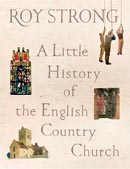Roy Strong's Little History
Sir Roy Strong's charming new book on English country churches informs and beguiles the reader


A Little History of the English Country Church
Roy Strong
(Jonathan Cape, £16.99)
How curious it is that an element of English life that seems to symbolise continuity, the village church, is really one of the greatest testaments to change. Sir Roy Strong's new book is a highly readable and intelligent narrative account of the changing practices of church building and worship since the arrival of Christianity to this island, written as much for people who have no understanding of the history of the village church as for those who cherish and cultivate these places, for reasons of committed Christian faith, for uncomplicated love of something local, or sense of place and history.
Sir Roy, expressly a church-goer himself, and a server at Hereford Cathedral, brings the story right up to the present, and, considering the future of the village church, asks whether more should not be done to put the church building at the service of the community, so that the village church can re-invent itself in just the way that the community of a village has been reinvented in the past half century. Sir Roy feels that they must be made to be part of social and spiritual life together: 'Change has been the lifeblood of the country church through the ages… [and] the real challenge lies in giving the country church a reason to survive.'
Sir Roy's voyage through the centuries of worship in the English parish church is an exemplar of fluid explanation: here, he explains the Roman Catholic tradition and the golden age of church building in the 14th, 15th and early 16th centuries, of the Reformation (which deprived the church of the systems of ritual and lay funding that had sustained music in liturgy until then), as well as the impact of the Civil War, evoking how often the only thing that didn't change was the building itself, although art, furnishings, liturgy, even clergy, might be turned over or out.
Each chapter opens with a touching description of a historic parish church that still captures the soul of an age in its fittings and decorations, and yet is still a work-ing church from St Mary and St David at Kilpeck to Long Melford in Suffolk, St Mary's Church in Fairford to St Issui's church at Patri-show, from St Mary, Abbey Dore, to St Barnabas, Brampton Bryan, so that in taking us on a tour of these places alone, we are instructed and enlightened everyone with any responsibility for our national life should be sent on a tour of them.
Exquisite houses, the beauty of Nature, and how to get the most from your life, straight to your inbox.
One feels that Sir Roy's innate sympathy is with the Catholic sacramental tradition, and shows how often change was imposed from above. But this book also assesses the changing prayer book and the quality of parish clergy throughout the ages. The 19th-century revival of church ritual is remarkable, as the Anglo-Catholic movement brought back candles, crosses and vestments as expected features of village parish-church ritual, as well as the hymns adopted from the Dissenting tradition, which remain so today.
Anyone with the slightest interest in the English parish church, of its life today, or its history or who is only conscious of the same draw of curiosity they give out, so brilliantly evoked by Philip Larkin in his poem Church Going will be intrigued, informed and enchanted by this lucid, and occasionally provocative, account.
Country Life is unlike any other magazine: the only glossy weekly on the newsstand and the only magazine that has been guest-edited by His Majesty The King not once, but twice. It is a celebration of modern rural life and all its diverse joys and pleasures — that was first published in Queen Victoria's Diamond Jubilee year. Our eclectic mixture of witty and informative content — from the most up-to-date property news and commentary and a coveted glimpse inside some of the UK's best houses and gardens, to gardening, the arts and interior design, written by experts in their field — still cannot be found in print or online, anywhere else.
